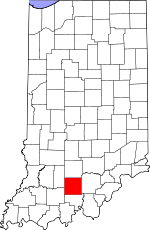






Please add profiles of those who were born, lived or died in Orange County, Indiana.
Orange County was formed by the Indiana Territorial Legislature, on December 26, 1815. The early settlers were mostly Quakers fleeing the institution of slavery in Orange County, North Carolina. Jonathan Lindley brought his group of Quakers from North Carolina to the area in 1811. They were the first to build a religious structure, the Lick Creek Meeting House in 1813. It was from this group that Orange County got its name. The name Orange derives from the Dutch Protestant House of Orange, which accessed the English throne with the accession of King William III in 1689, following the Glorious Revolution.
When the North Carolina Quakers came to Indiana, they brought several freed slaves. These free men were deeded 200 acres of land in the heart of a dense forest. Word of mouth soon spread the news, and this land became part of the "underground railroad" for runaway slaves. For many years, the freed slaves in this area farmed, traded, and sold their labor to others while living in this settlement. A church and cemetery were constructed.
Abydel | Bacon | Bonds | Bromer | Chambersburg | Ethel | Fargo (formerly Pittsburgh) | French Lick | Greenbrier | Greenfield | Hindostan | Jackson | Leipsic (formerly Lancaster ) | Lost River | Mahan Crossing | Millersburg | Newton Stewart | Northeast | Northwest | Norton (formerly Dillon) | Orangeville | Orleans | Paoli (County Seat) | Pearsontown | Pine Valley | Prospect (formerly New Prospect) | Pumpkin Center | Rego | Roland | Scarlet | Southeast | Stampers Creek | Syria | Trotter Crossing | Turleys | Valeene | West Baden Springs | Woodlawn Grove | Youngs Creek (formerly Unionville)
Orange County Cemeteries
Cemeteries of Indiana
National Register of Historic Places
Hoosier National Forest (part)
Index to Will Records of Orange County - (1816-1852)
